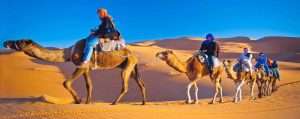
Maranjab Desert
Contents
Maranjab Desert
Where Is the Maranjab Desert?
Undoubtedly, by looking at the pictures of this beautiful desert, you would also be willing to visit Maranjab and its attractions. The Maranjab Desert is located north of Aran va Bidgol, in Kashan City, and Isfahan Province. Maranjab is the name of a caravanserai and also a qanat (ancient underground water system) belonging to the Safavid Period, later has been calling for the whole area around them. From the north there is Aran va Bidgol Salt Lake, from west Masileh Desert, Howz-e Soltan and Howz-e Mareh Lakes, from east Band-e Rig Desert and Khabr National Park, and from the south is the Aran va Bidgol City. There are different routes to reach the Maranjab Desert like the Khaled Abad Route inside Abu Zeid Abad District southeast of Kashan but the best and most commonly used route in order to reach this region is from Kashan City.
The Distance Between Aran va Bidgol and Kashan
The Distance Between Aran va Bidgol and Kashan is 13 kilometers. When you arrive at the dirt road between the two cities, you must drive about 20 minutes in order to travel the distance between Aran va Bidgol and Kashan. To go from Tehran to Kashan, first, you should enter Tehran-Qom Freeway and then drive through the Qom-Kashan Freeway. After driving 230 kilometers you will arrive at the Qaem welfare service complex that you can recognize by its gas station. Enter the complex area, drive through the underpass after it, and then go left. Now you are on the old road or Jadeh Qadim of Kashan. On this road turn right at the first crossroad and drive on the Qotb Ravandi Boulevard till you reach Montazeri Square. From the Square, enter Kargar street and drive till you reach Azadegan Square, and then enter Ayatollah Ameli Boulevard. After moving past the military (on the right) and karkhaneh Foolad Road, you reach the end of the main road. After the Helal bin Ali Mosque, you should enter a narrow path toward the Maranjab Dirt Road. There are a signboard and a booth at the entrance of this dirt road that show the path. From this spot, you just need to drive the distance between Aran va Bidgol and Kashan to reach the Maranjab Desert. The distance is approximately 13 kilometers and could be driven in about 20 minutes.
Why Is It Called “Maranjab”?
“Maranjab” like many other places and structures belonging to the Safavid Period has an interesting name. Shah Abas of the Safavid Dynasty named this desert “Maranjab” or “Mard-Ranj-Ab” meaning “Man-Pain-Water” because digging wells and qanats was so difficult and people needed to go through pain and labor in order to reach freshwater. As time passed, “Mard-Ranj-Ab” turned into “Maranjab” which is the name called by people today.
Why Should We Visit the Maranjab Desert?
Maranjab is located on the ancient Silk Road and its caravanserai used to be the connecting point of Isfahan and Khorasan provinces. This desert is among the few deserts that have various animal species and different plants because the climate provides enough food and water for the flora and fauna. Animals like Rüppell’s fox, sand cat, monitor lizard, chameleon, see-see partridge, eagle, and hawk and plants such as tamarisk, haloxylon, arteh, calligonum comosum, and smirnovia iranica trees and bushes like zygophyllum eurypterum are some of the flora and fauna of this region. The pictures of the Maranjab Desert with its tall sand dunes and small tamarisk and haloxylon trees catch every traveler’s attention. The Salt Lake and starry night sky also complete the beauty of Maranjab. Visiting Maranjab will become a unique experience that you don’t want to miss.
The Attractions of the Maranjab Desert
As you enter the dirt road toward Maranjab until you arrive at the caravanserai, you need to drive about 40 kilometers. On the way, you will encounter small tamarisk and haloxylon trees with spaghetti-like leaves that on the inside they are full of water. The camels of the region use them to quench their thirst. Because of coolness, the monitor lizards live under the trees and feed on their roots. In the middle of the route, you will encounter a steep slope called “Khatb Shekan”. After Khatb Shekan you reach a salt marsh called “Chah Kanjeh”. Then you arrive at the Salt Lake Fork. One of these paths is dedicated to the unrefined salt trucks. The lake is full of salt. After each rain and water evaporation, the salt crystals form beautiful hexagonal shapes. They are among the most amazing attractions of the Maranjab Desert. After visiting the lake, you will see “Jazireh Sargardan”. Then you will reach Shah Abbasi Caravanserai. 4 kilometers away from the caravanserai, there is “Chah-e Dastkan” or “handmaid well” that is another attraction of the area. Because of the sand filters, salty groundwater gets purified in the well and provides freshwater.
Recreational Activities in the Maranjab Desert
Recreational activities in the Maranjab Desert due to its high number of attractions are diverse and numerous. You can also visit this desert and see its beauty and wonders. Visiting various flora and fauna, the starry night sky, Salt Lake, Dastkan Well, and Jazireh Sargardan are some of the activities that nature lovers can experience. Camel, ATV, and off-road riding are other entertainments for those who want to pump some adrenaline!
Jazireh Sargardan
Jazireh Sargardan (meaning wandering island) is an amazing part of the Maranjab Desert, inside Salt Lake. A layer of white salt has covered the circumference of this low-height hill. This island is formed of spongy volcanic stones and has no vegetation. There is always dense mist on the hillside that causes an optical illusion and the hill seems like a wandering ship on the sea. That is why it is called Jazireh Sargardan or wandering island. The ground around the island is marshy so you should be careful when you approach the island.
Accommodations in the Maranjab Desert
If you are one of those guys that always look for a hotel to stay in, you should change your habits! You cannot stay at a hotel in the Maranjab Desert. But after visiting the natural attractions of the desert, you can go to the Maranjab Caravanserai and have some rest. Abbasi Caravanserai of Maranjab is a caravanserai that has remained from the Safavid Era in the middle of the desert. This caravanserai used to be a place of rest for the caravans and it is now the best place to stay in the Maranjab Desert.
When Should We Go to the Maranjab Desert?
Traveling to the desert is exciting in each season. But after the weather cools down the number of travelers increases. The best season for traveling to the desert is the autumn and the second half of November because the route is dry and the weather is pleasant. So, from the first days of autumn until the first days of spring is an appropriate time to travel to the Maranjab Desert because the weather is cooler and more pleasant in comparison to the other months.
What Should We Bring to the Desert?
Before we begin our travel to the desert areas, we must have the necessary information and travel consciously. If you want to travel to the Maranjab Desert it is better to bring a local tour guide with you and we recommend you not to travel alone. On your trip to Maranjab, make sure that you are wearing proper hiking shoes or hiking sandals. In addition to food and drinking water, it is better to bring light nutrients such as almonds. If you are traveling to Maranjab in a cold season, make sure to bring warm and proper clothes with you. Furthermore, don’t forget to bring sunglasses and a cap. And of course, don’t forget your camera; to capture photos of your wonderful journey.
Traveling by a Rental or Your Own Vehicle
It is better to read these tips if you are one of those travelers who want to travel by private vehicle:
- In order to reach the desert, it is better to use the route of Aran va Bidgol City.
- It is possible to go to the Maranjab Desert by private vehicle, but if you don’t have an SUV make sure to travel with two cars so that you can tow the vehicle.
- If you don’t have a local guide, stick to the main routes.
- Bring a few days more share of drinking water and at least one day more share of food.
- Your cellphones will only have a signal within the 30 kilometers reach from the caravanserai, so if you are in trouble use other ways such as burning a tire to inform others.
- And last but not least, make sure that you don’t leave any trash behind so that we could maintain and protect the unique environment of the Maranjab Desert.



